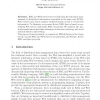SEMWEB
2004
Springer
14 years 4 months ago
2004
Springer
Semantic Web Services enable the dynamic discovery of services based on a formal, explicit specification of the requester needs. The actual Web Services that will be used to satis...
SEMWEB
2004
Springer
14 years 4 months ago
2004
Springer
Researchers have recognized the need for more expressive descriptions of Web services. Most approaches have suggested using ontologies to either describe the Web services or to an...
OTM
2004
Springer
14 years 4 months ago
2004
Springer
UN/CEFACT’s Modeling Methodology (UMM) has been developed to analyze and design B2B business processes independent of the underlying exchange technology. It became the methodolog...
OOPSLA
2004
Springer
14 years 4 months ago
2004
Springer
Effective and affordable business process integration is a key concern in the finance industry. A large German joint-use centre, supplying services to 237 individual savings banks...
INTELLCOMM
2004
Springer
14 years 4 months ago
2004
Springer
This paper discusses possible routes to moving the web from a collection of human readable pieces of information connecting humans, to a web that connects computing devices based o...
IFIP
2004
Springer
14 years 4 months ago
2004
Springer
Peer-to-peer systems, exchanging dynamic documents through Web services, are a simple and effective platform for data integration on the internet. Dynamic documents can contain b...
ICWE
2004
Springer
14 years 4 months ago
2004
Springer
The situation in engineering security for Web services that access databases is as follows: On the one hand, specifications like WSSecurity are concerned with the security managem...
ICSR
2004
Springer
14 years 4 months ago
2004
Springer
Abstract. Designing systems of asynchronous web services is challenging. Addressing the design in terms of component reuse helps address important questions that need to be answere...
ICCS
2004
Springer
14 years 5 months ago
2004
Springer
The distributed information technologies collectively known as Web services recently have demonstrated powerful capabilities for scalable interoperation of heterogeneous software a...
FASE
2004
Springer
14 years 5 months ago
2004
Springer
Abstract. XML and Web services are revolutioning the automatic management of distributed information, somewhat in the same way HTML, Web browser and search engines modified human ...







